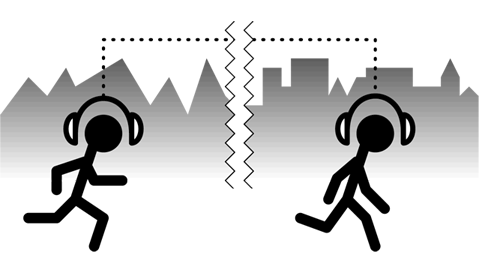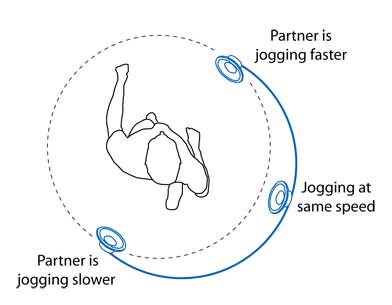Jogging over a Distance
Jogging over a Distance supports pace awareness through spatialized audio: if you are faster, her/his voice comes from behind, if you are slower, her/his voice is in front of you.
NEW: If you are a jogger or runner, and have jogging friends in other cities, please see our blog!
Social Jogging
We have found through the use of an online survey and Internet forums that joggers often run with others. Out of 77 responses from regular joggers 57% replied that they run with at least one other person. The top four reasons for running with others were:
-
socializing (83%)
-
motivation to run faster (78%)
-
to have more fun (53%)
-
to be encouraged to show up (53%)
We discovered that many social joggers value the ability to have conversations with their partners and use their exercise sessions as a way to stay in touch with their friends. For casual joggers, being able to hold a conversation can also be an indicator that they are running at a suitable pace: not too fast and not too slow for an optimal health benefit. This is often referred to as the “Talk Test”.
One respondent noted,
“ About twice a month I run with some of the girls I went to college with. It's a great time to chat and catch up! Even though we see each other and chat regularly, we always seem to talk more openly while we run.”
Another participant gave an example of the benefits he received from running with a partner:
“I ran on Sunday with another runner, and she wanted to add a little more distance to the route. We talked about it as we ran and agreed where to run. I ran more than I would have if I ran by myself. After the run, I was glad that I did the extra mileage. Also, my running companion ran faster than I would have in the early part of the run (I actually had to ask her to slow down a little for the 1st mile), and I think I pushed her at the end of the run. It was mutually beneficial.”
For one competitive runner, social jogging motivated him to jog on non-competition days. He explained,
“Well, I go faster when I’m by myself, but I don’t have nearly as much fun, and I wouldn’t do it. I don’t go out by myself normally. If I didn’t have a group I was meeting somewhere I probably wouldn’t bother. I’d just be miserable. So, yeah, it gets me out. ”
A frustration participants have with social jogging is finding the ‘right’ jogging partner: one who can meet them at the same location and who jogs at roughly the same pace. This challenge of finding a partner resulted from people moving away or, through training, becoming faster than their jogging partner. One jogger explained that he only has one friend whom he could run with, but his friend moved across the country and
“now I know of no one my age who runs the way I do… many run longer and a lot run shorter... I still wish I knew people to run with to shake things up a bit.”
Another recently re-located runner stated,
“I run alone, [but] I wish I could find a couple of people to run with but haven’t had much luck in finding a running partner since I moved two years ago. ”
Jogging over a Distance

One possible solution that facilitates finding social jogging partners is to enable people to jog with remote friends and other remote joggers. With Jogging over a Distance, jogging partners could live in opposite parts of the world, yet share the experience of jogging together.
We were interested in the experience joggers would have if they would communicate with a remote partner through an audio channel only, and therefore asked 18 volunteers to go running at the same time, but in opposite directions, equipped with a mobile phone and a Bluetooth headset. We were intrigued by how much of a sense of presence the audio conveyed to the participants: they not only mentioned hearing the other person’s voice, but also the wind, the noise of the footsteps depending on the ground surface, and the breathing of the remote jogger, which they amounted to a social and enjoyable experience. Two of the participants took up our idea and decided to jog regularly together through a mobile phone connection beyond the duration of the study, confirming that remote jogging with an audio interface can result in a desirable experience.
Pace Awareness
We decided to build a prototype that further pushes the idea of jogging “together” with geographically distant jogging partners by creating a prototype that not only supports conversation but uses the audio to communicate pace. Similar to jogging side by side and adjusting pace with one’s partner, the Jogging over a Distance prototype transforms the conversation into spatialized audio to simulate hearing one’s partner in front, to the side, or behind.
Jogging over a Distance Experience
With our latest prototype, Jogging over a Distance, each jogging partner puts on a pair of headphones and wears the remaining equipment in a small backpack. While each partner jogs, speed data is collected and used to position the audio of the conversation in a 2D sound plane, oriented horizontally around the jogger’s head. As one jogger speaks, their partner hears the localized audio and is able to detect whether the audio is coming from the front, the side, or from behind, and thus the other person is jogging faster, at the same pace, or slower. Similar to a collocated setting, the audio cues runners when to speed up or slow down in order to “stay” with their partner. The joggers can discuss running routes, motivate each other to keep pace, or simply listen to the environment noises of the other location. For joggers with differing athletic abilities who would like to have the experience of running together, a baseline pace variable can be adjusted that allows each runner to push their own personal pace rather than try to run at their partner’s speed. Thus, the system allows joggers to do something that is not possible when running side by side - challenge their individual pace while running with friends who run at different speeds.
Technical Implementation
Jogging over a Distance consists of two identical systems, each with a miniature computer, a Bluetooth GPS device, a wireless modem, a mobile phone and a headset. Each system is carried in a small, close fitting backpack while the user jogs. (Although the prototype currently requires weighty equipment to be worn by the jogger, we envision a final product to be only slightly bigger than an iPod, a device often worn by joggers.) Each mini computer is connected to a commercial wireless broadband service, which covers the major urban parks in which our joggers run. Speed and time data is collected via the GPS device and sent to the mini computer via Bluetooth. The computer then transmits this data wirelessly over the 3G network to a server, which calculates the speed difference and adjusts for GPS inconsistencies. The server determines how fast each jogger is running in relation to his or her partner. As a result of this, an algorithm calculates a sound position value for each jogger. As each jogger talks, their voice is picked up by a microphone and the audio is transmitted via a conventional mobile phone. (We initially used VoIP technology, but found the lag and reliability insufficient for our purposes.) Before routing the incoming audio from the remote jogger’s mobile phone to the headphones, the mini computer applies a spatialization algorithm to the sound source. The mini computer uses the sound position value received from the server to transform the audio data into spatial 2D audio by placing the sound source onto an imaginary plane around the joggers head. The result is that the jogger hears their partner’s voice coming from a certain direction.
Acknowledgements
This work was based on a survey on social jogging, which was initially supported by CeNTIE (Centre for Networking Technologies for the Information Economy), which is supported by the Australian Government through the Advanced Networks Program (ANP) of the Department of Communications, Information Technology and the Arts and the CSIRO ICT Centre. We would like to thank Chris Wolf and all our participants. Thanks also to Lana Dauberman for shooting the video.
Publications
O'Brien, S., Mueller, F., Thorogood, A. Jogging the Distance, CHI 2007 (PDF) (this describes mostly the survey)
Mueller, F., O'Brien, S., Thorogood, A. Jogging over a Distance, CHI 2007 (PDF) (this describes mostly the prototype)
Press
Discovery News: http://dsc.discovery.com/news/2007/05/10/joggingbuddy_tec.html?category=technology&guid=20070510100000
ABC: http://abc.net.au/science/news/stories/2007/1920528.htm?tech
The University of Melbourne Voice: http://uninews.unimelb.edu.au/articleid_4246.html
Bright magazine (Netherlands): http://www.bright.nl/solo-sociaal-hardlopen-zet-aan-tot-grotere-prestaties
Information Aesthetics: http://infosthetics.com/archives/2007/05/jogging_over_a_distance.html
Textually.org: http://www.textually.org/textually/archives/2007/05/015897.htm
ACM Tech News: http://technews.acm.org/archives.cfm?fo=2007-05-may/may-14-2007.html#311543
A2mediagroup: http://www.a2mediagroup.com/pdf.php?a=15087
What's new: http://www.whatsnew.tv/Article.aspx?id=143
Computerpoweruser: http://www.computerpoweruser.com/editorial/article.asp?article=articles%2Farchive%2Fc0709%2F64c09%2F64c09.asp
Radio: (broadcasted in Australia as part of whatsnew.tv) jogging_over_a_distance.mp3
Contact
Video
The video from above is also available to download (right-click, save as) in MPEG 2 format (DVD quality, 39 MB) and iPod format (MP4, 8 MB).
NEW: If you are a jogger or runner, and have jogging friends in other cities, please see our blog!

